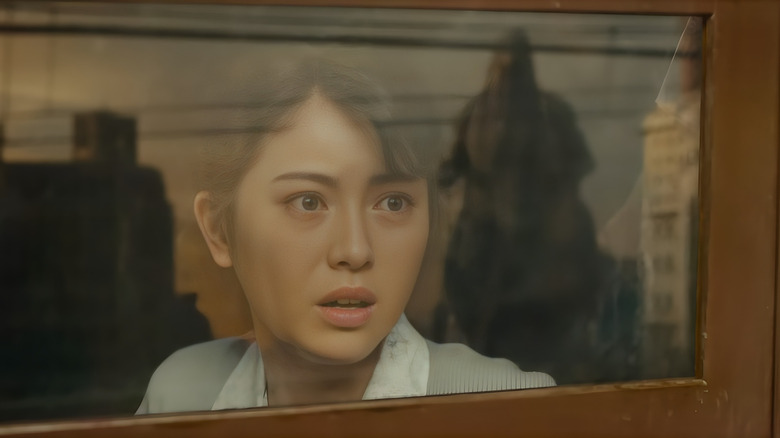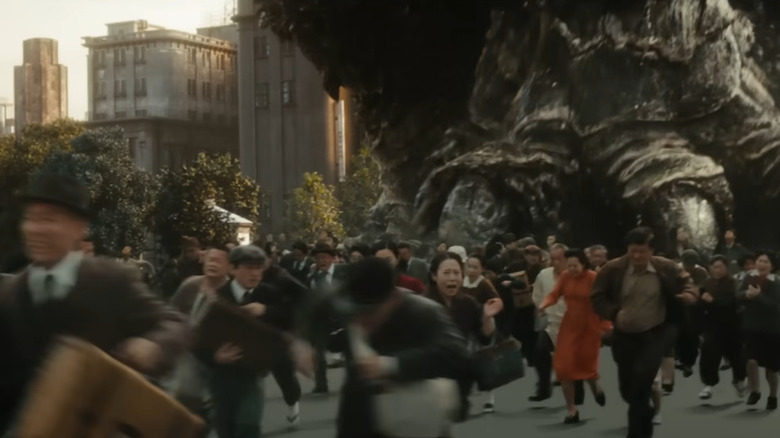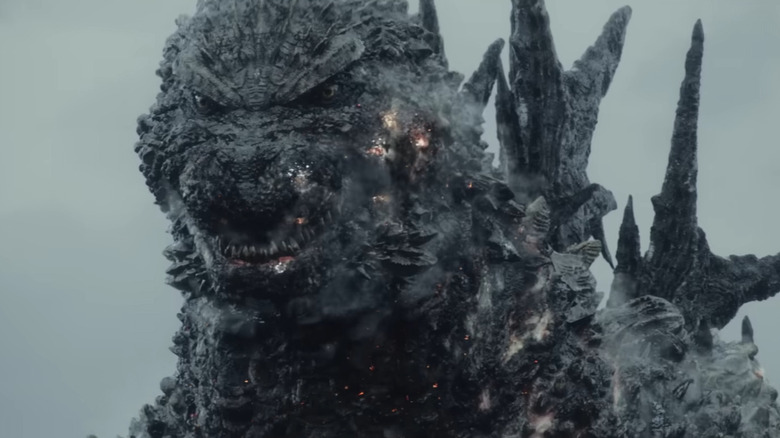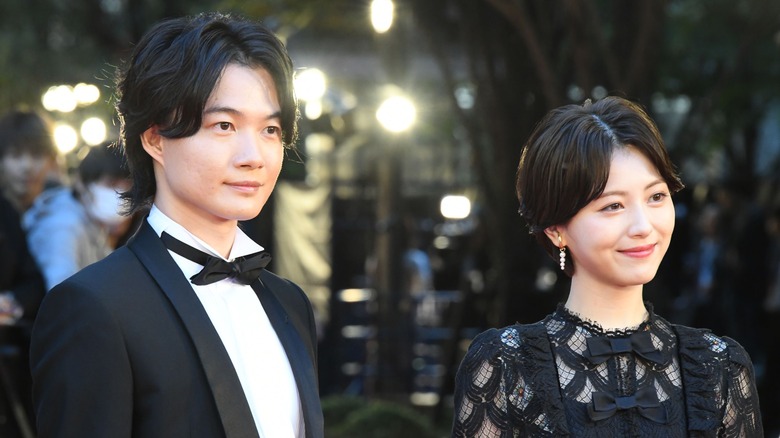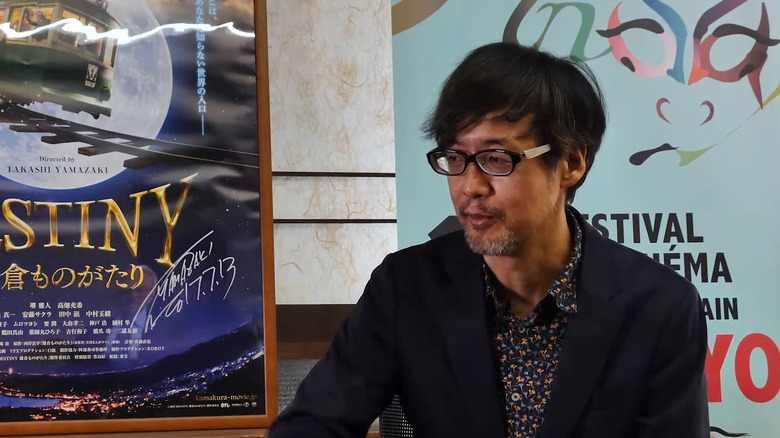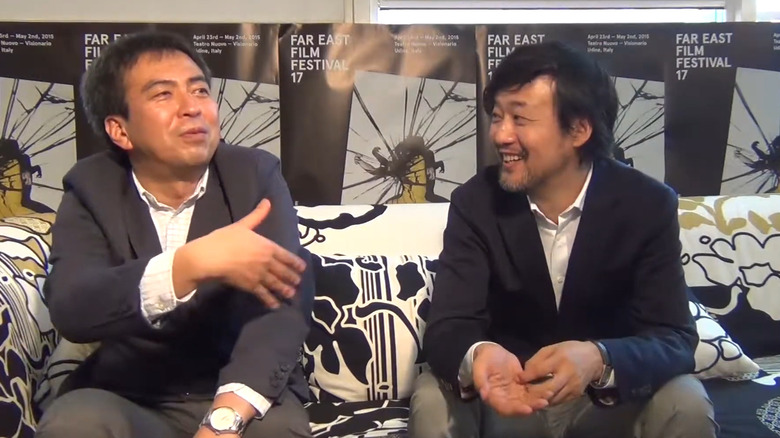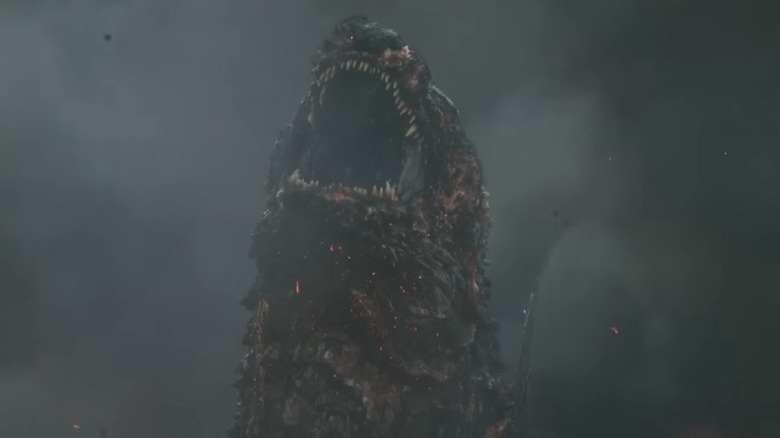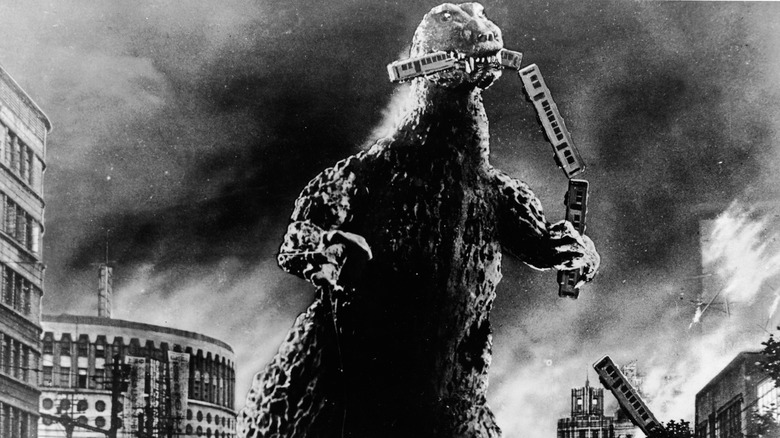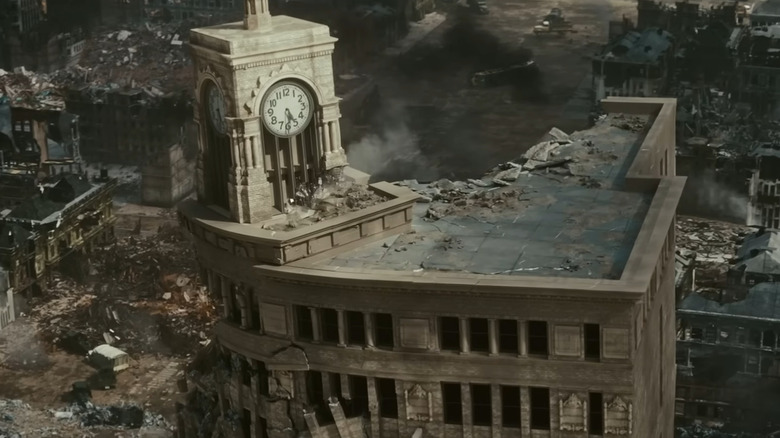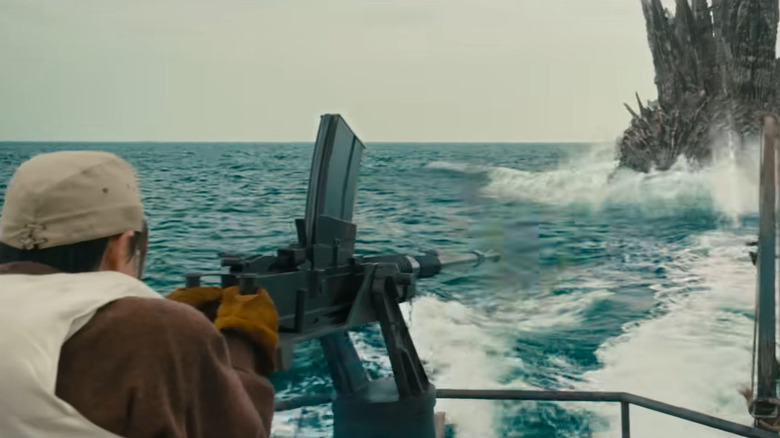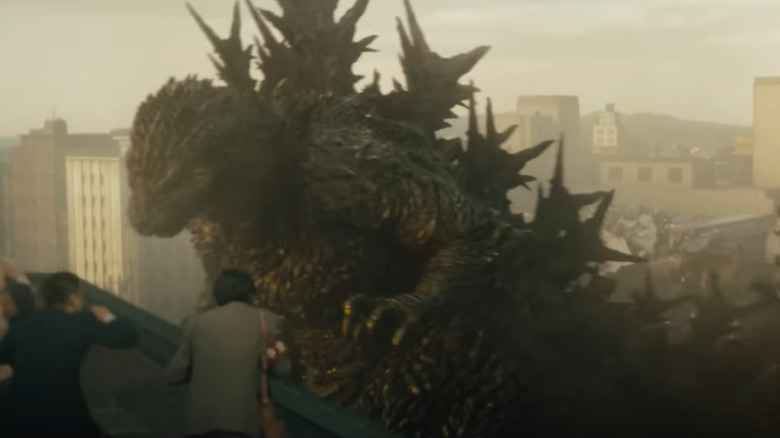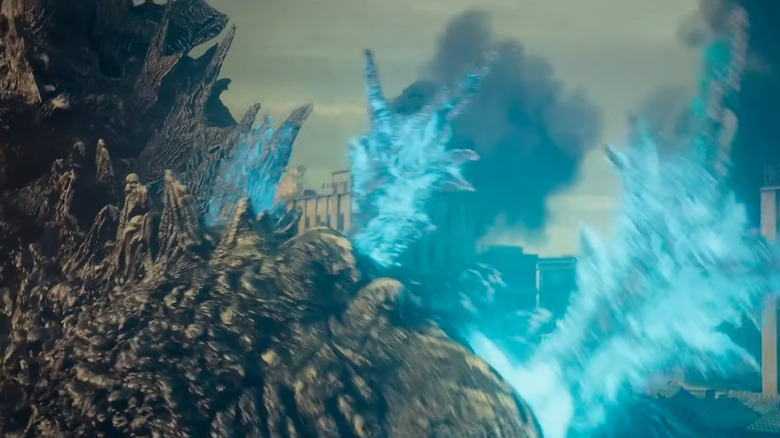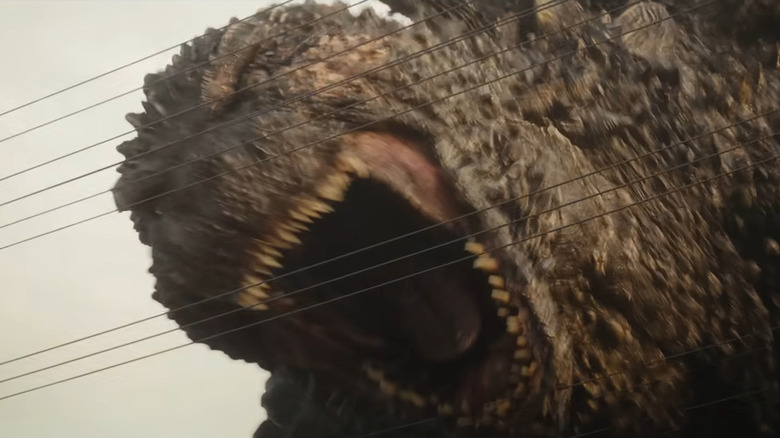Godzilla Minus One Release Date, Cast, Director, Trailer, And More Details
As Godzilla's 70th anniversary approaches, it seems like we're getting more kaiju content than ever before. But while upcoming American productions such as "Monarch: Legacy of Monsters" and "Godzilla x Kong: The New Empire" are sure to get fans hyped, it is "Godzilla Minus One" that is perhaps the most intriguing. The upcoming standalone entry not only brings the king of the monsters back to his Japanese homeland, but also seems to be returning the franchise to its horrifying and allegorical origins.
Since 2014's "Godzilla" brought the famous Toho kaiju out of a decade-long hiatus, the king of the monsters has been more prevalent in the mainstream than ever before, with Japanese and American projects being produced concurrently for the first time. But while many of the films under Legendary's ongoing MonsterVerse saga have been made as crowd-pleasing blockbusters, a few standalone releases have aimed to use Godzilla as a metaphor for contemporary topics, with the most notable being 2016's satirically-fueled and critically-lauded "Shin Godzilla."
Upon first glance, "Godzilla Minus One" may not appear to have the bells and whistles of other recent entries, but there's more here than meets the eye. With its unique premise and a passionate team in front of and behind the camera, "Minus One" is shaping up to be another richly thematic and stand-out installment in the nearly 40-film franchise.
When will Godzilla Minus One be released?
"Godzilla Minus One" had its theatrical debut in Japan on November 3, 2023, the same day that the original "Godzilla" was released in 1954. Prior to this, the film had its red carpet premiere at Kabukichō, Shinjuku, Tokyo on October 18, and will act as the closing film at the Tokyo Film Festival. "Minus One" will have its North American debut on December 1.
Following Toho's "Shin Godzilla," the studio announced that it would not be able to produce another live-action Godzilla film until after 2020 as part of its deal with Legendary Pictures, producers of the MonsterVerse. During that time, the company primarily turned to making anime content featuring Godzilla for Netflix, including a 3D animated film trilogy released between 2017 and 2018 and the series titled "Godzilla Singular Point."
It wouldn't be until November 3, 2022, that a then-untitled Toho-produced "Godzilla" film was announced to commemorate the franchise's 70th anniversary. Post-production commenced at this point, with principal photography taking place between March and June 2022.
What's the plot of Godzilla Minus One?
So far, all we have for the plot of "Godzilla Minus One" is a synopsis from the movie's official press release. It reads, "The worst despair in the series' history strikes Japan! After the war, Japan has been reduced to zero. Godzilla appears and plunges the country into a negative state. The most desperate situation in the history of Japan. Who? And how? Will Japan stand up to it?"
While the Godzilla franchise has long explored humanity's relationship with nuclear weapons, only the original 1954 film directly contends with the postwar trauma experienced by Japan. At the time, the devastating 1945 atomic bomb attacks of Hiroshima and Nagasaki were still fresh in the minds of audiences. Godzilla stood as a living, breathing metaphor for the unforgiving destruction that such super weapons can create, which is part of what has helped the kaiju king stand out from other movie monsters.
"Godzilla Minus One" seems to be taking this a step further, taking place in the direct aftermath of World War II as Japan is still recovering from the devastation. There may even be a darkly spiritual side to the story, as writer and director Takashi Yamazaki has been open about finding inspiration from 2001's "Godzilla, Mothra, and King Ghidorah: Giant Monsters All-Out Attack," an entry that sees the forgotten souls of World War II soldiers possess and use Godzilla as the instrument for their revenge. Whichever direction it takes, "Godzilla Minus One" is shaping up to be amongst the most chilling entries in the franchise.
Who is starring in Godzilla Minus One?
Starring in the lead roles of "Godzilla Minus One" are Ryunosuke Kamiki and Minami Hamabe as Kōichi Shikishima and Noriko Ōishi, respectively. The two characters are war survivors who meet each other in a devastated Japan. The two actors starred alongside one another in the drama series "Ranman," but were offered their roles in "Minus One" prior to working on the show.
Kamiki became well-known for voicing several characters for Studio Ghibli during his younger years. His first was Boh, the giant baby from Hayao Miyazaki's "Spirited Away." Over the years, he voiced characters in other Ghibli films, such as "Howl's Moving Castle" and "The Secret World of Arrietty," as well as other notable anime films, such as "Summer Wars," "Your Name," and "Suzume." He's also appeared in other well-known Japanese franchise entries like "Kamen Rider Agito," "Doraemon: Nobita's Dinosaur 2006," and "Evangelion: 3.0+1.0 Thrice Upon a Time." In 2006, he earned a Japan Academy Film Prize as best newcomer of the year for his role in "The Great Yokai War."
Hamabe had been active in the industry since 2012, but became widely recognized for her role in 2017's "Let Me Eat Your Pancreas." The role earned her a newcomer prize from the Japan Academy Awards in 2018. She has since starred in numerous films and TV shows, including "Minus One," Takashi Yamazaki's 2019 film "The Great War of Archimedes," and 2023's "Shin Kamen Rider." Others in the "Godzilla Minus One" cast include Hiroki Yamada, Takataka Aoki, Hidetaka Yoshioka, Sakura Ando, and Kuranosuke Sasaki.
Who is directing Godzilla Minus One?
Directing "Godzilla Minus One" is prolific filmmaker Takashi Yamazaki. Along with directing the movie, he also wrote the film's screenplay and supervised its visual effects.
Yamazaki has become a celebrated director throughout Japan. Movies such as "Star Wars" and "Close Encounters of the Third Kind" influenced Yamazaki to enter the world of filmmaking and special effects. After working at the animation house Shirogumi in the late 1980s, he ventured out to create his own films, starting with the 2000 sci-fi fantasy "Juvenile." Yamazaki gained notoriety after helming 2005's "Always: Sunset on Third Street." The film won big at the Japan Academy Awards, taking home 12 prizes including a best director and screenplay win for Yamazaki. He went on to helm its two sequels, with 2007's "Always: Sunset on Third Street 2" having a notable cameo from a fully computer-generated Godzilla towards the beginning. He has also successfully adapted several notable anime and manga titles, such as 2010's "Space Battleship Yamato," 2014's "Stand by Me Doraemon," and 2019's "Lupin III: The First."
Along with the aforementioned Godzilla cameo in "Third Street 2," Yamazaki also had a hand in creating "Godzilla the Ride: Giant Monsters Ultimate Battle" for the Seibu-en amusement park in Tokyo. In the film's official press release, Yamazaki shared, "I think this is the culmination of all the films I have made to date and one that deserves to be 'experienced' rather than 'watched' in the theater. I hope you will experience the most terrifying Godzilla in the best possible environment."
Who is writing and producing Godzilla Minus One?
The aforementioned Takashi Yamazaki is the sole screenwriter of "Godzilla Minus One." Following his 2019 film "The Great War of Archimedes," Yamazaki was picked to take on "Godzilla Minus One" and it took him three years to complete the script.
There are four producers on "Godzilla Minus One." Minami Ichikawa has the most experience working in the "Godzilla" franchise, starting his career as a publicist for 1989's "Godzilla vs. Biollante," and eventually becoming a chief producer and production manager on 2016's "Shin Godzilla." Along with these, he has also worked on the producing team of "Spirited Away," "Ponyo," "Wolf Children," "Shin Ultraman," and Takashi Yamazaki's "Parasyte" duology to name a few.
Keiichiro Moriya has also had a long-standing professional relationship with Yamazaki. Their first collaboration came in 2005 when Moriya produced "Always: Sunset on Third Street" and the two worked with each other again on "The Fighter Pilot," the "Stand by Me Doraemon" duology, and the "Parasyte" duology. Also on the team are "Monster" producer Kenji Yamada and "Love Me, Love Me Not" producer Kazuaki Kishida.
Is there a trailer for Godzilla Minus One?
On July 11, the first teaser for "Godzilla Minus One" came out. Leading up to the teaser, Toho began a daily countdown on Twitter presenting all 29 live-action Japanese-made Godzilla films as a way of building up anticipation. The tactic proved to be a successful one, as the first teaser — which showcased snippets of a decimated Tokyo and a quick glimpse of Godzilla biting a train — garnered positive reactions from fans and has reached 1.5 million views.
A more substantial trailer was released on September 3. It opens in a similar manner as the teaser, presenting the chaos and devastation of Godzilla's attack. There are also sections that show meetings taking place, with one person stating, "The government is not telling the public," indicating a potential point of conflict. Subsequent shots see Godzilla destroying various ships as tensions rise, concluding with a near-dead individual proclaiming, "That monster ... will never forgive us."
The imagery, tone, and subject matter presented in the "Minus One" trailer make it appear as though the film will be acting as a near remake of the original 1954 film. That movie not only emphasized the seismic destruction of Godzilla's power, but also contained its fair share of social and political commentary, including scenes in which it's debated whether Godzilla should be revealed publicly or not. Whether or not this is the case, the trailer for "Minus One" is sure to get fans pumped for what's sure to be an unsettling experience.
What will Godzilla Minus One be rated?
Interestingly, "Godzilla Minus One" has two very different ratings depending on where you see the film. The Film Classification and Rating Organization, also known as Eirin, in Japan granted the film a "G" classification. Meanwhile, "Minus One" has been given a PG-13 rating by the Motion Picture Association in the United States. The MPA bestowed this rating upon the movie for its "creature violence and action."
This drastic difference in film ratings is certainly interesting to compare. A G rating wouldn't seem too weird for some of the more family-oriented Godzilla entries, but "Godzilla Minus One" is an entirely different beast judging from the trailers alone. Ratings of the previous Godzilla films aren't widely available, so it's hard to determine how "Minus One" stacks up in this department. Compared to some of the other more mature efforts within the franchise, the film will likely contain its fair share of harrowing moments, but the overall experience shouldn't deter younger viewers. In the end, it is ultimately up to parents to know how much their children can handle.
What should viewers watch before Godzilla Minus One
While "Godzilla Minus One" appears to be a standalone entry, the film's arrival is a great opportunity for newcomers to the long-running franchise to see what all the fuss is about. With over 36 films and counting spanning nearly 70 years, the good news is that the series — which is split into four distinct eras known as Showa (1954-1975), Hesei (1984-1995), Millennium (1999-2004), and Reiwa (2016-present) — doesn't share a singular continuity and you can watch nearly any entry out of order.
Ishiro Honda's 1954 "Godzilla" is must-watch viewing, not only for introducing the iconic character, but also for its cultural and social significance in the grander context of cinema history. This film — and all other Showa entries with the exception of "King Kong vs. Godzilla" — can be streamed for free on Tubi and YouTube, as well as on Max or the Criterion Channel with a subscription. Hesei installments that are worth checking out include "Godzilla vs. King Ghidorah" and "Godzilla vs. Destoroyah," both of which can be streamed for free on Pluto. "Godzilla, Mothra and King Ghidorah: Giant Monsters All-Out Attack," "Godzilla Against Mechagodzilla," and "Godzilla: Tokyo S.O.S." are amongst the stand-out films in the Millennium series and can also be streamed on Pluto.
The Reiwa era that "Minus One" is part of currently consists of "Shin Godzilla" and an anime trilogy starting with 2017's "Godzilla: Planet of Monsters" and ending with "Godzilla: The Planet Eater." "Shin" can be seen by premium subscribers of Amazon Prime or Crunchyroll, while the entire anime trilogy is available on Netflix.
Who is on the Godzilla Minus One soundtrack?
Just as iconic as the kaiju of the Godzilla franchise is the music that underscores every Tokyo rampage. The original Godzilla theme by Akira Ifukube remains a central pillar of the series, popping up time and time again throughout different iterations. More modern entries have also contributed some memorable scores, such as 2001's "Godzilla, Mothra and King Ghidorah: Giant Monsters All-Out Attack," which served as a major inspiration for "Godzilla Minus One."
The score for "Minus One" was composed by Naoki Satō. A graduate of the Tokyo College of Music, Satō has been scoring major films, TV series, and anime in Japan for decades. His past work includes the "Pretty Cure" anime series, the live-action "Rurouni Kenshin" movies, and several collaborations with "Godzilla Minus One" director Takashi Yamazaki, such as "Parasyte: Part 1," "Parasyte: Part 2," and "The Great War of Archimedes." Over the past several years, Satō has scored some projects that have achieved great success outside of Japan — most notably the hit anime series "Assassination Classroom" and the movie "Dragon Ball Super: Super Hero."
Though this is Satō's first Godzilla film, it's clear from the trailers that he knows what he's doing. The clips we've heard so far evoke Akira Ifukube's classic sound, which is appropriate given the setting of the new movie.
What have early reviews said about Godzilla Minus One?
Though international fans are still waiting patiently for "Godzilla Minus One," the film has already been released in Japan, premiering in wide release on November 3, 2023. That means that early reviews are out, and most of them speak quite positively about the latest entry in the franchise.
At the time of this writing, "Godzilla Minus One" has a solid four-out-of-five fan rating on Japanese review aggregator Filmarks — just barely higher than the critically acclaimed "Shin Godzilla." Critics have been similarly complimentary. Polygon's Chris Plante praised the film, calling it "the throwback Godzilla fans have been waiting for" and saying that it faithfully follows up on the success of "Shin Godzilla." Richard Eisenbeis of Anime News Network called the movie "fantastic," writing, "Its premise is a great one, and watching the various characters come together to try to defeat Godzilla when their resources are so limited is incredibly engaging."
Even Gareth Edwards, director of 2014's "Godzilla" — which kicked off the MonsterVerse – has spoken out in celebration of the film. "There were a lot of things that I felt were very new for Godzilla, and I felt jealous the whole time I was watching the movie," Edwards told Japan's Cinema Today (via ComicBook.com). "This is what a Godzilla movie should be." The director even claimed that "Minus One" was in contention for the best Godzilla film ever made, in his opinion.
Will Godzilla fight another kaiju in Godzilla Minus One?
For decades, Godzilla movies were defined by (and often named after) the other kaiju involved. "Godzilla vs. Mothra," "Godzilla vs. Mechagodzilla," "Godzilla vs. Megaguirus," and many others all brought in titanic foes for Godzilla to fight. Sometimes he was the hero, sometimes he was the villain, but these battles were a constant centerpiece regardless of the plot.
That approach has remained central to the MonsterVerse version of Godzilla, but the Japanese Reiwa Era films – Godzilla movies produced from 2016 onwards — have largely drifted away from the "monster vs. monster" structure of the '70s, '80s, and '90s. Like "Shin Godzilla" before it, "Godzilla Minus One" only features one kaiju — the big guy with his name on the poster. Though it's set at a very different point in time than its immediate predecessor, "Minus One" is still focused on humanity's struggle against Godzilla. Both recent live-action films from Toho take a more thematically rich approach, with Godzilla being just as much a symbol of real-world issues as he is a giant monster. When the story revolves around some giant kaiju duel, those more literary ideas can be harder to explore.
Fans of the old movies might be disappointed that we're only getting Godzilla here again, but there's still hope that Toho could produce a classic kaiju battle at some point in the future. We've had them in the recent anime movies and the MonsterVerse, but Toho hasn't featured a live-action kaiju battle for Godzilla since 2004's "Godzilla: Final Wars."
What does Godzilla look like in the new movie?
Since "Godzilla Minus One" is a new, independent story, fans might be wondering what version of the famous kaiju we're getting. While the trailers feature some good shots of the big guy, they keep his full form somewhat hidden, leaving it for the movie to unveil.
Godzilla diehards know that the King of the Monsters has gone through many iterations, from his original rubber suit to the slim, blue-fired form of the Heisei Era films, to the beefier, orange-fired version seen in "Godzilla 2000," to the mountainous iteration of the MonsterVerse. That's without even mentioning more isolated versions like the purple-tinged, Lovecraftian look of "Shin Godzilla" or the 300-meter-tall anime incarnation known as Godzilla Earth.
In "Godzilla Minus One," the eponymous lizard has gotten yet another makeover, but it pulls clear inspiration from previous versions. His head and upper body are significantly more muscular than they were in "Shin Godzilla," making him resemble both the "Godzilla 2000" design and MonsterVerse version. We also see that he has his traditional blue atomic fire this time around, as opposed to the purple blasts from "Shin." A new addition is the way the spines on Godzilla's tail extend while charging up the projectile attack. Still, the "Minus One" design retains the shorter arms and upright posture of the classic rubber suit films, paying tribute to the series' past.
Could Godzilla Minus One start a new story?
Ever since 2004's "Godzilla: Final Wars," Toho has refrained from starting a new live-action saga. Even that film was more a homage to the entire series' legacy than a direct sequel to its predecessors. The trilogy of anime Godzilla films all share a core story and continuity, but many fans still view them as side projects. On the live-action side, "Shin Godzilla" rebooted things completely, and now "Godzilla Minus One" is rebooting them again.
In both films, Godzilla is an unknown quantity, rather than the familiar threat he is in most of his movies. This angle fits with the movies' lack of other kaiju characters. But with Toho now seemingly back on a somewhat regular release schedule — and the financial success of the MonsterVerse — it's possible that we could get a proper live-action continuity in the future.
Could "Minus One" be the start of a new Godzilla series? That remains to be seen. Its setting in the wake of World War II aligns it with the beginnings of the franchise, which could make it an optimal foundation to build on. At the same time, that setting is very thematically specific, so it doesn't necessarily foreshadow a direct sequel. The Reiwa Era has been defined by independent projects that all put a different spin on Godzilla himself. That may continue to be the case after "Godzilla Minus One."
